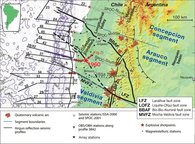Active continental margins constitute one of Earth's most hazardous living environments due to the dangers posed by destructive earthquakes and volcanoes. Nevertheless, due to many factors, such as climate, resources and accessibility, these regions are often heavily populated. Thus it is of great importance to study the structures and processes which shape the plate boundary region associated with an active margin and, in particular, the seismically coupled part of the subduction zone where nearly all the earthquakes with magnitude greater than 8 occur. Although geophysical studies of many of Earth's subduction zones have been carried out there are still areas that are poorly studied. One such area is southern Chile where in 1960 the largest earthquake ever recorded instrumentally (Mw = 9.5) occurred. A knowledge of the structures and processes which shape the subduction zone in south Chile will lead to a better earthquake hazard assessment for the region. In November 2001 a network of reflection profiles utilizing airgun sources was shot using the RV Sonne across the continental margin of southern Chile, in the vicinity of the source region of the 1960 earthquake. Utilizing onshore recordings of the airgun sources and additional onshore and offshore sources, a combined onshore-offshore, active-passive seismic project between 36°S and 39°S was realized. This project comprised i) a pilot near-vertical incidence reflection (NVR) seismic experiment covering the onshore-offshore transition along an E-W line at 38°15´S, ii) three consecutive E-W wide-angle reflection / refraction (WRR) lines at 36°20´S, 37°15´S and 38°15´S, iii) an array of 30 stations for recording both active and passive sources and iv) six broadband stations along a profile at 39°S. The pilot NVR experiment at 38°15´S covers the near-shore part of the subduction zone between the South American and Nazca plates along the westernmost part of a longer WRR line. The main aim of the experiment was to test the structural and reflectivity potential along the seismogenic plate interface. The 54 km long E-W line was set up in three spreads and recorded 14 shots fired at 10 different locations. This resulted in a single-fold CDP coverage along 71 km profile length encompassing a 45 km long portion with two-fold coverage. In addition, the airgun shots of the offshore extension of the profile were recorded with the first 18 km of the onshore NVR spread. The three WRR profiles comprised on the source side the airgun pulses from the offshore extension of the respective profiles and 2-4 chemical shots mainly at the ends of the onshore profiles and on the recording side 52 three-component stations. In addition, along the offshore extension of the profile at 38°15´S, 22 OBH/OBS stations also recorded airgun pulses along this profile. The array consisted of 24 three-component short-period and six three-component broadband stations and had dimensions of 100 km in the E-W direction and 200 km in the N-S direction. The major aim of the WRR experiments was to obtain a 3-D velocity model for the crust and uppermost mantle of the forearc region for this part of southern Chile.
Time Frame
- November 2001 (experiment)
Principal Investigators
- Prof. Dr. M. Weber (GFZ Potsdam)
- Prof. Dr. O. Oncken (GFZ Potsdam)
- J. Mechie (GFZ Potsdam))
- Prof. Dr. C. Krawczyk (BGR Hannover, now GFZ Potsdam))
- M. Stiller (GFZ Potsdam)
- Dr. P. Wigger (Free University Berlin)
Cooperations
- SFB 267 "Deformation Processes in the Andes", Free University, Berlin BGR (Bundesanstalt für Geowissenschaften und Rohstoffe), Hannover, GEOMAR, Kiel, Universidad de Concepción, Chile, Universidad de Chile, Santiago, Chile, SEGMI, Chile, SERNAGEOMIN, Chile, IGM, Chile, ENAP, Chile
Methods & Equipment
- wide-angle reflection/refraction, near-vertical incidence reflection, short-period and broadband passive recording - 30 Refteks, 40 PDAS and six Guralp CMG-3ESPD / SAM-2 from GIPP, 12 PDAS from FU Berlin
Publications/Results
- Krawczyk, C. and the SPOC Team, 2003. Amphibious seismic survey images plate interface at 1960 Chile earthquake. EOS Trans. Am. Geophys. Union, 84: 301, 304-305.
- Krawczyk, C.M., Mechie, J., Lüth, S., Tasárová, Z., Wigger, P., Stiller, M., Brasse, H., Echtler, H.P., Araneda, M. and Bataille, K., 2006. Geophysical signatures and active tectonics at the South-Central Chilean margin. In: O. Oncken, G. Chong, G. Franz, P. Giese, H.-J. Götze, V.A. Ramos, M.R. Strecker and P. Wigger (Editors), The Andes - Active Subduction Orogeny. Frontiers in Earth Sciences Series, Springer, Berlin, Heidelberg, New York, pp. 171-192.



